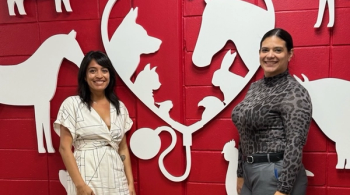
SLIDESHOW: Success in mixed animal practice
Veterinarians with a heart for small-town life find big opportunities with mixed-animal practice.
The veterinary profession has watched large animal work decline with the country's dwindling number of family farms and economic challenges. Yet, many rural veterinarians have found success in mixed animal practice. In fact, some experts say rural mixed animal practice is on the rise.
A 37-year veteran of rural practice, Rexanne Struve, DVM, examines a horse's teeth while tending to animals on a farm near her mixed animal practice, Veterinary Associates of Manning, in rural western Iowa.
Photo by Christopher Gannon/The Des Moines Register
Steven Hjartarson, DVM, returned to his hometown of Cut Bank, Mont., in 2009 with his wife and young family. He purchased Northern Veterinary Clinic, the mixed-animal practice he worked at as a teenager. He says his gross receipts have grown 157 percent since he purchased the clinic in the town of less than 3,000 people. Photo by Jason Savage
Struve says she spends about 70 percent of her time caring for small animals and about 30 percent large animals. Her average exam rate is $41.30, but she says her client numbers and average charges are, on average, increasing regularly.
Photo by Christopher Gannon/The Des Moines Register
Struve says living and working in the same little town her clients do is one of the best things about rural practice. “I shop in all the places my clients do, eat in the same restaurants and go to the same church," she says. “I love being a part of the community." She also loves the type of people who associate with the different types of animals she sees. “A person who enjoys snakes is different from a person who rides horses or one who would own a pocket pet," she says. “I love the variety of the people I see as much as I do the variety of pets I see."
Photo by Christopher Gannon/The Des Moines Register
“One of the biggest issues is to deliver a calf or pull a pig, come in a mess, and have to go straight into a small animal appointment," she says. Struve often wears coveralls or rubber suits for messy appointments. Then she can quickly strip it off, wash her hands and be presentable for indoor work in a moment's notice. Photo by Christopher Gannon/The Des Moines Register
Struve examines a calf while tending to animals on a farm near Manning, Iowa. “Cattle work might be on the decline in some areas, but that doesn't mean revenue has to decline, too." She says rural veterinarians have to be entrepreneurs and look for additional revenue streams.
Struve currently employs an adjunct business to her practice. She cares for cesarean-derived colostrum-deprived (CDCD) pigs that vaccine companies use to test vaccines. “In rural areas, there are plenty of opportunities for veterinarians beyond just getting clients in the door," she says. “This has been a great source of practice income for us. A mixed animal practitioner definitely does not have to work an adjunct business to be successful, but in a small town, you have to reach farther to draw in business." Photo by Christopher Gannon/The Des Moines Register
Struve examines a dog while tending to animals on a farm near Manning, Iowa. “There are only so many small animals or large animals in a small town from which to build your business,” Struve says.
Struve has seen times of plenty and some much leaner times in her 37 years of practice. She says her “bulldog tenacity” has gotten her through, as have great staff members, smart business decisions and a willingness to serve many types of patients that others might not see. Photo by Christopher Gannon/The Des Moines Register
Hjartarson examines a patient while at his clinic in Cut Bank, Mont. Hjartarson says he spends about 60 percent of his time working with small animals and 40 percent with large animals. He says small animal patients make up 75 percent of his revenue. His average exam rate is $38. Photo by Jason Savage
Busy is the fall with pregnancy checks for the area's cattle, Hjartarson is often out of office and out in the field. “Scheduling is one of the most important aspects of making mixed animal practice work,” he says. “I try not to schedule myself out on the field too many days to allow me to catch up at the office, and I typically don't schedule my weekends, except for herd work at this time of the year.” Photo by Jason Savage
Hjartarson heads out to work with cattle on a Saturday. He says he enjoys offering front-line care for as many clients as possible, no matter the kind of animal. “I think that stems from my ideas of what a veterinarian does from when I was a kid,” he says. “That's what I saw growing up in this community." Photo by Jason Savage
Hjartarson performs a pregnancy check on a cow outside of his hometown, Cut Bank, Mont. Owner of a rural mixed animal practice, he says his small animal appointments and large animal appointments ebb and flow. “In the summer, cattle work slows down but small animal work is up,” he says. “Then in the fall, when school starts and small animal clients are busy with other things, I see a rise in cattle work. And again in February, I see more calving work. It all balances out.” Photo by Jason Savage
Hjartarson continues pregnancy checks on a ranch outside of his hometown. The family values and culture of Cut Bank, Mont., drew him back to begin his own practice and raise his small family. "My wife works in the same school my 6- and 8-year-old children attend, and we know the parents and children that our kids interact with. Living and working in a small town gives us a feeling of security.” Photo by Jason Savage
To read more about Struve, Hjartarson and rural mixed animal practice, and also see a video with Dr. Struve, go to
Newsletter
From exam room tips to practice management insights, get trusted veterinary news delivered straight to your inbox—subscribe to dvm360.






